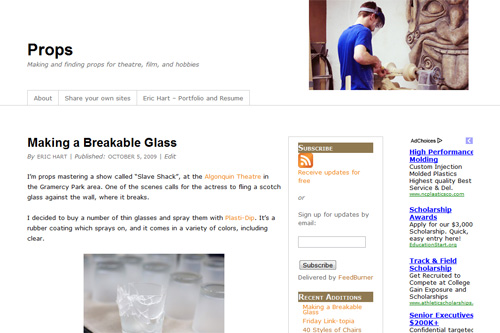While my new book is one of the most exciting things on the horizon, let’s not forget that this blog continues to deliver lots of fun and free writing about props, and it will do so long after the book comes out. This blog turned four years old last week, and I almost forgot about it! I thought it would be fun to recap what has appeared here, just like I did after the first year, the second year, and the third year. It now contains 585 published posts, with a total of 266,384 words; that’s one and a half times as many in my book!
I’ve written a few little “featurettes” in the past year. I try to discover who the first prop maker was. I show off some photographs of prop artifacts held at the Victoria and Albert Museum. I take a look at prop expenses from 1716. I had a multi-part series of how they built Fafner the dragon at every production of The Ring Cycle which the Metropolitan Opera has done since it was founded (part one, part two, and part three). I explored who invented the jig saw, and looked at whether it should be called a saber saw or a jig saw. I did a story called To Broadway and Back, and looked at where to find summer jobs. I also did a few safety-oriented posts: Weapon Safety is nothing new, and The Nose Knows Not.
I have toured some places and wrote about some events. These include Wesley Cannon’s awesome film prop collection, a visit to Roy Underhill’s Woodwright’s School, a visit and lesson at Dick Snow’s blacksmithing shop, the Burlington (North Carolina) Mini Maker Faire, a tour of the Costume Armour facilities in New York, and the NYC Annual Props Summit.
I added some more of my own illustrations, including formal dinner settings, and “Better Proud than Shy“. I have begun shooting a lot more video in the past year, such as adding a flange to PVC pipe, vacuum forming for zero dollars, an exploding cuckoo clock, sculpting in oil clay, making a plaster mold, and sculpting and carving foam.
Of course, I posted pictures and explanations of various props I have built: Furniture for Henry IV and V at Playmakers Rep, a crepe cart at the Santa Fe Opera, a six-foot tall microscope, a dead deer at Shakespeare in the Park, King Roger’s throne at the Santa Fe Opera, twelve candlestick phones for Elon University, a player piano for Elon, various props for Crazy for You at Elon, Milky the Cow, Puppets for Into the Woods, some box elder boxes, and a CNC cast iron bench.
This year, I’ve also published some cool things submitted by other people. First up is Specter Studios building a foam axe prop, followed by the condensed history of their company. Next up is Costume Armour making a disappearing turkey. I also posted the video of Jay Duckworth’s KCACTF keynote speech on being a props master.
Regular readers know I like to dig out old historical writings about props. This year, these included the following: Actors in IATSE (1898), Backstage Views (1900), What Becomes of Stage Scenery (1903), A multi-part reprint of an article on prop maker E.L. Morse (1904): part 1, part 2, part 3, part 4, part 5, part 6, and part 7; The Covetous Property Man (1904), A Factory for Making Plays (1909), Good Furniture and Moving Pictures (1915), How David Belasco shops for props (1919), William Bradley, Property Man (1927), Why Film Prop Men Often Die in Their Youth (1938).
There were also some great illustrations I’ve reprinted here: daggers and poniards of the Christian Middle Ages, an illustration detailing the construction of a table, cooking pots history, 1642-1969, chair back styles, and construction and upholstery of chairs.
Finally, I reviewed Costumes and Chemistry by Silvia Moss. Though not a review, I also did a brief interview with Sandra Strawn about her recently published book, The Properties Director’s Handbook.
So there you have Year Four in a nutshell. I post lots of other links and videos in addition to what I’ve written here. If you don’t want to miss any future posts, you can subscribe to my blog with your favorite blog reader, or sign up to get all articles through email. For even extra prop goodness, you can follow me on Twitter as well.

